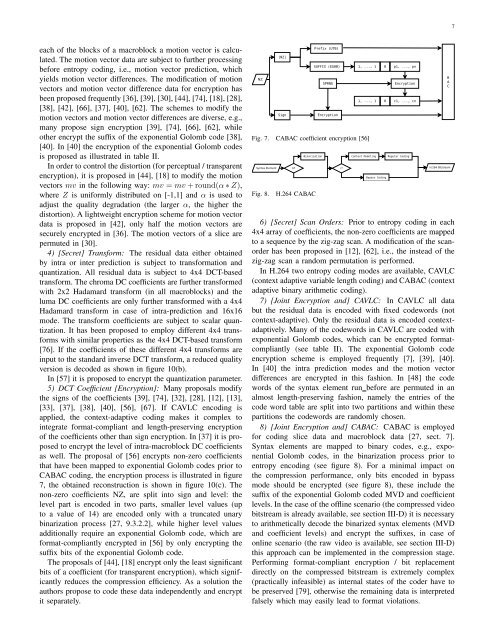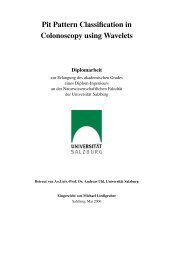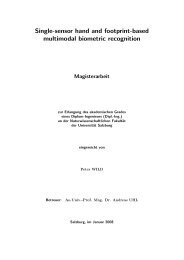7each <strong>of</strong> the blocks <strong>of</strong> a macroblock a motion vector is calculated.The motion vector data are subject to further processingbefore entropy coding, i.e., motion vector prediction, whichyields motion vector differences. The modification <strong>of</strong> motionvectors and motion vector difference data for encryption hasbeen proposed frequently [36], [39], [30], [44], [74], [18], [28],[38], [42], [66], [37], [40], [62]. The schemes to modify themotion vectors and motion vector differences are diverse, e.g.,many propose sign encryption [39], [74], [66], [62], whileother encrypt the suffix <strong>of</strong> the exponential Golomb code [38],[40]. In [40] the encryption <strong>of</strong> the exponential Golomb codesis proposed as illustrated in table II.In order to control the distortion (for perceptual / transparentencryption), it is proposed in [44], [18] to modify the motionvectors mv in the following way: mv = mv + round(α ∗ Z),where Z is uniformly distributed on [-1,1] and α is used toadjust the quality degradation (the larger α, the higher thedistortion). A lightweight encryption scheme for motion vectordata is proposed in [42], only half the motion vectors aresecurely encrypted in [36]. The motion vectors <strong>of</strong> a slice arepermuted in [30].4) [Secret] Transform: The residual data either obtainedby intra or inter prediction is subject to transformation andquantization. All residual data is subject to 4x4 DCT-basedtransform. The chroma DC coefficients are further transformedwith 2x2 Hadamard transform (in all macroblocks) and theluma DC coefficients are only further transformed with a 4x4Hadamard transform in case <strong>of</strong> intra-prediction and 16x16mode. The transform coefficients are subject to scalar quantization.It has been proposed to employ different 4x4 transformswith similar properties as the 4x4 DCT-based transform[76]. If the coefficients <strong>of</strong> these different 4x4 transforms areinput to the standard inverse DCT transform, a reduced qualityversion is decoded as shown in figure 10(b).In [57] it is proposed to encrypt the quantization parameter.5) DCT Coefficient [<strong>Encryption</strong>]: Many proposals modifythe signs <strong>of</strong> the coefficients [39], [74], [32], [28], [12], [13],[33], [37], [38], [40], [56], [67]. If CAVLC encoding isapplied, the context-adaptive coding makes it complex tointegrate format-compliant and length-preserving encryption<strong>of</strong> the coefficients other than sign encryption. In [37] it is proposedto encrypt the level <strong>of</strong> intra-macroblock DC coefficientsas well. The proposal <strong>of</strong> [56] encrypts non-zero coefficientsthat have been mapped to exponential Golomb codes prior toCABAC coding, the encryption process is illustrated in figure7, the obtained reconstruction is shown in figure 10(c). Thenon-zero coefficients NZ, are split into sign and level: thelevel part is encoded in two parts, smaller level values (upto a value <strong>of</strong> 14) are encoded only with a truncated unarybinarization process [27, 9.3.2.2], while higher level valuesadditionally require an exponential Golomb code, which areformat-compliantly encrypted in [56] by only encrypting thesuffix bits <strong>of</strong> the exponential Golomb code.The proposals <strong>of</strong> [44], [18] encrypt only the least significantbits <strong>of</strong> a coefficient (for transparent encryption), which significantlyreduces the compression efficiency. As a solution theauthors propose to code these data independently and encryptit separately.NZ|NZ|SignPrefix (UTB)SUFFIX (EG0B)SPRNG<strong>Encryption</strong>1, ..., 1 0 p1, ..., pn1, ..., 1Fig. 7. CABAC coefficient encryption [56]Fig. 8.<strong>H.264</strong> CABAC0<strong>Encryption</strong>c1, ..., cn6) [Secret] Scan Orders: Prior to entropy coding in each4x4 array <strong>of</strong> coefficients, the non-zero coefficients are mappedto a sequence by the zig-zag scan. A modification <strong>of</strong> the scanorderhas been proposed in [12], [62], i.e., the instead <strong>of</strong> thezig-zag scan a random permutation is performed.In <strong>H.264</strong> two entropy coding modes are available, CAVLC(context adaptive variable length coding) and CABAC (contextadaptive binary arithmetic coding).7) [Joint <strong>Encryption</strong> and] CAVLC: In CAVLC all databut the residual data is encoded with fixed codewords (notcontext-adaptive). Only the residual data is encoded contextadaptively.Many <strong>of</strong> the codewords in CAVLC are coded withexponential Golomb codes, which can be encrypted formatcompliantly(see table II). The exponential Golomb codeencryption scheme is employed frequently [7], [39], [40].In [40] the intra prediction modes and the motion vectordifferences are encrypted in this fashion. In [48] the codewords <strong>of</strong> the syntax element run before are permuted in analmost length-preserving fashion, namely the entries <strong>of</strong> thecode word table are split into two partitions and within thesepartitions the codewords are randomly chosen.8) [Joint <strong>Encryption</strong> and] CABAC: CABAC is employedfor coding slice data and macroblock data [27, sect. 7].Syntax elements are mapped to binary codes, e.g., exponentialGolomb codes, in the binarization process prior toentropy encoding (see figure 8). For a minimal impact onthe compression performance, only bits encoded in bypassmode should be encrypted (see figure 8), these include thesuffix <strong>of</strong> the exponential Golomb coded MVD and coefficientlevels. In the case <strong>of</strong> the <strong>of</strong>fline scenario (the compressed videobitstream is already available, see section III-D) it is necessaryto arithmetically decode the binarized syntax elements (MVDand coefficient levels) and encrypt the suffixes, in case <strong>of</strong>online scenario (the raw video is available, see section III-D)this approach can be implemented in the compression stage.Performing format-compliant encryption / bit replacementdirectly on the compressed bitstream is extremely complex(practically infeasible) as internal states <strong>of</strong> the coder have tobe preserved [79], otherwise the remaining data is interpretedfalsely which may easily lead to format violations.BAC
8Compression-oriented encryption schemes can be combined(see table III for possible combinations) and figure 10(d) fora visual example <strong>of</strong> the quality reduction for a combination <strong>of</strong>MVD, DCT coefficient and inter-PM encryption.Video<strong>H.264</strong> EncodeXMLXSLT Process<strong>H.264</strong> BitstreamA(XML)Adaptation EngineAdapted <strong>H.264</strong>C. Bitstream [Oriented <strong>Encryption</strong>]The output <strong>of</strong> <strong>H.264</strong> encoding is a bitstream (coded videosequence) which is given as a sequence <strong>of</strong> NALUs (networkabstraction layer units).1) NALU [<strong>Encryption</strong>]: The fully format-compliant encryption<strong>of</strong> the NALUs with simple encryption algorithms,e.g., comparable to packet body encryption in JPEG2000 [15],is not possible due to the violation <strong>of</strong> syntactical and semanticalrequirements. In JPEG2000, the encryption <strong>of</strong> packet bodydata is possible as only fractional bitplane data is coded, i.e.,every decoded bit sequence can be interpreted as fractionalbitplane data, while <strong>H.264</strong> arithmetically encodes a multitude<strong>of</strong> syntax elements, not all syntax element values are alwayspossible. The decoding <strong>of</strong> a ill-suited syntax element value(by decoding encrypted data) leads to violations <strong>of</strong> semanticalrequirements after arithmetic decoding, e.g., a value out <strong>of</strong>range.However, given the appropriate encryption schemes whichavoid the generation <strong>of</strong> marker sequences [19], regular NALUprocessing can be conducted on the compressed and encryptedbitstream. The preservation <strong>of</strong> the NAL structure and syntaxrequirements enable the transparent application <strong>of</strong> packagingmethods [59], [19], which is a prerequisite for efficient transmission.The encryption <strong>of</strong> NALUs and preservation <strong>of</strong> theNALU header has been proposed in [81], [5], [19]. In [59],[19] it is highlighted that encrypted data can be transparentlyand efficiently signalled by the application <strong>of</strong> unspecifiedNALU types (NUTs) for encrypted NALUs, which then haveto be ignored by a <strong>H.264</strong> decoder [27, sect. 7.4.1].2) Container-Formats: Several proposals [24], [23], [22]employ container formats and encrypt the <strong>H.264</strong> bitstream orfractions <strong>of</strong> the <strong>H.264</strong> bitstream with conventional algorithms,e.g., AES in counter mode. The basic setup is illustrated infigure 9. In the compression process, additionally an XMLdescription <strong>of</strong> the bitstream is produced. This XML descriptioncan be used to adapt the bitstream (see [29] for an evaluationfor <strong>H.264</strong>). The same description can also be used to efficientlyidentify parts <strong>of</strong> the bitstream suitable for encryption.There is a standard for secure streaming <strong>of</strong> RTP data, including<strong>H.264</strong>:<strong>AVC</strong>/<strong>SVC</strong> [21]. If container formats are employedfunctionality can be preserved through explicit signalling inthe container format, e.g., all NAL based functionality can bepreserved.3) Partial / Selective <strong>Encryption</strong>: Partial encryption <strong>of</strong><strong>H.264</strong> bitstreams can reduce the amount <strong>of</strong> data to encryptand can also lead to performance improvements in a streamingsystem [19]: results are presented for base layer encryptionand IDR picture encryption (<strong>of</strong> an <strong>SVC</strong> bitstream), whichcorresponds to the encryption <strong>of</strong> a certain subset <strong>of</strong> the NALUs<strong>of</strong> the bitstream. Figure 10(e) shows a possible reconstructionif IDR picture encryption is applied, we have replaced the IDRpicture by a picture <strong>of</strong> zero values (a replacement attack) andFig. 9.MPEG-21 encryption and adaptation<strong>Encryption</strong> EngineEncrypted Adapted <strong>H.264</strong>figure 10(f) and 10(g) show the result <strong>of</strong> a replacement attackagainst base layer encryption (we have replaced the base layerpicture by a picture <strong>of</strong> zero values). Another approach is topartially encrypt NALUs [24], i.e., only parts <strong>of</strong> a NALU areencrypted. The encryption <strong>of</strong> the leading fraction <strong>of</strong> a NALUrenders the entire NALU not decodeable by standard decoders,which could be employed to effectively implement contentconfidentiality. The idea <strong>of</strong> selective encryption could also beapplied to container format data, e.g., it has been proposedto only encrypt parts <strong>of</strong> the RTP header [2]. In [61] thisRTP header encryption scheme, which is also applicable to<strong>H.264</strong> RTP transmission, is analyzed. It is concluded that RTPheader encryption <strong>of</strong> RTP streams containing <strong>H.264</strong> data isinsufficient to ensure security (with respect to all discussedsecurity notions, i.e., the entire video can be reconstructed).D. An Overview <strong>of</strong> <strong>SVC</strong> [<strong>Encryption</strong>]1) <strong>Encryption</strong> before Compression: There are no dedicatedencryption proposals that take <strong>SVC</strong>-specifics into account.2) Compression [Integrated <strong>Encryption</strong>]: The base layer isencoded similar to <strong>AVC</strong>, thus all encryption schemes for <strong>AVC</strong>can be basically employed in the base layer. The enhancementlayers can employ inter-layer prediction, but not necessarilyhave to, e.g., if inter-layer prediction does not result inbetter compression. The compression integrated encryptionapproaches for <strong>AVC</strong> can be applied as well for <strong>SVC</strong>, e.g., theapproaches targeting the coefficient data can also be appliedfor <strong>SVC</strong>.3) Bitstream [Oriented <strong>Encryption</strong>]: The approach <strong>of</strong> [59]takes advantage <strong>of</strong> <strong>SVC</strong> to implement transparent encryptionafter compression. The following approaches have been proposedfor <strong>SVC</strong> encryption [3], [5], [19], [65], which all preservethe NALU structure and encrypt almost all <strong>of</strong> the NALUpayload. As the NALU structure is preserved, scalability ispreserved in the encrypted domain.V. SOLUTIONS, ANALYSIS AND DISCUSSIONIn the following we discuss suitable encryption algorithmsfor the distinct security and application scenarios on the basis<strong>of</strong> our presented evaluation criteria (see section III-D).A. Highest Level SecurityThis application scenario is hardly discussed in literatureand none <strong>of</strong> the discussed approaches is capable to meet itsrequirements.








